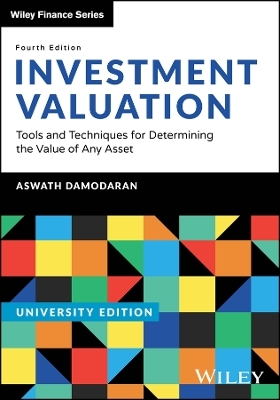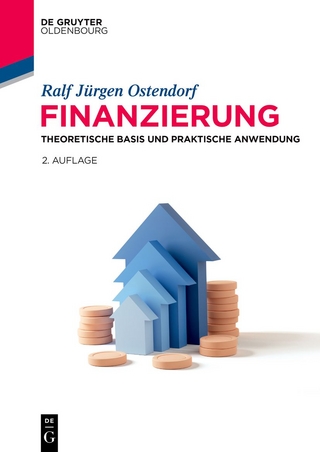
Investment Valuation, University Edition
John Wiley & Sons Inc (Verlag)
978-1-394-26273-1 (ISBN)
Investment Valuation: Tools and Techniques for Determining the Value of Any Asset delves into valuation techniques for a variety of different asset classes, including real options, start-up firms, unconventional assets, distressed companies and private equity, real estate, and many more, and explains how to choose the right model for any given asset valuation scenario. The models are presented with real-world examples so as to capture some of the problems inherent in applying these models, with discussion of differences and common elements between the models to provide readers with a holistic understanding of the subject matter.
Written by a professor of finance who is widely regarded as one of the best educators and thinkers on the topic of investment valuation, this newly revised and updated Fourth Edition explores topics including:
Understanding financial statements, the basics of risk, and tests and evidence for market efficiency
Estimating risk parameters and costs of financing, terminal value, and equity value per share
Using scenario analysis, decision trees, and simulations for probabilistic approaches in valuation
Investment Valuation: Tools and Techniques for Determining the Value of Any Asset is an essential resource for all investors and students of financial markets seeking an all-in-one guide to expand their valuation knowledge and make better investment decisions.
ASWATH DAMODARAN is Professor of Finance at New York University’s Leonard N. Stern School of Business. He teaches corporate finance and valuation at leading investment banks. He has been the recipient of numerous awards for outstanding teaching, including the NYU Distinguished Teaching Award, and was named one of the nation’s top business school teachers by BusinessWeek. His publications include Damodaran on Valuation, Applied Corporate Finance, The Little Book of Valuation, Investment Philosophies, and The Dark Side of Valuation.
Preface xv
Chapter 1 Introduction to Valuation 1
A Philosophical Basis for Valuation 1
Pricing versus Valuation 2
The Bermuda Triangle of Valuation 2
Market Efficiency 6
The Role of Valuation 7
Conclusion 10
Questions and Short Problems 10
Chapter 2 Approaches to Valuation 13
Intrinsic Valuation 13
Pricing or Relative Valuation 21
Contingent Claim Valuation 25
Conclusion 27
Questions and Short Problems 27
Chapter 3 Understanding Financial Statements 29
The Basic Accounting Statements 29
Asset Measurement and Valuation 31
Measuring Financing mix 38
Measuring Earnings and Profitability 44
Measuring Risk 50
Other Issues in Analyzing Financial Statements 56
Conclusion 57
Questions and Short Problems 58
Chapter 4 The Basics of Risk 61
What Is Risk? 61
Equity Risk and Expected Return 62
Alternative Models for Equity Risk 74
A Comparative Analysis of Equity Risk Models 80
Models of Default Risk 81
Conclusion 85
Questions and Short Problems 85
Chapter 5 Option Pricing Theory and Models 91
Basics of Option Pricing 91
Option Pricing Models 94
Extensions of Option Pricing 109
Conclusion 110
Questions and Short Problems 111
Chapter 6 Market Efficiency—Definition, Tests, and Evidence 113
Market Efficiency and Investment Valuation 113
What Is an Efficient Market? 114
Testing Market Efficiency 118
Cardinal Sins in Testing Market Efficiency 123
Some Lesser Sins That Can Be a Problem 124
Evidence on Market Efficiency 125
Time Series Properties of Price Changes 125
Market Reaction to Information Events 133
Market Anomalies 137
Evidence on Insiders and Investment Professionals 146
Conclusion 152
Questions and Short Problems 153
Chapter 7 Riskless Rates and Risk Premiums 157
The Risk-Free Rate 157
Equity Risk Premium 162
Default Spreads on Bonds 182
Conclusion 185
Questions and Short Problems 186
Chapter 8 Estimating Risk Parameters and Costs of Financing 189
The Cost of Equity and Capital 189
Cost of Equity 190
From Cost of Equity to Cost of Capital 221
Best Practices at Firms 233
Conclusion 234
Questions and Short Problems 234
Chapter 9 Measuring Earnings 241
The Lead-in: From Accounting Data to Financial Information 241
Adjusting Earnings 243
Measuring Earnings Power: Clean Up and Time Differences 256
Conclusion 266
Questions and Short Problems 267
Chapter 10 From Earnings To Cash Flows 269
The Tax Effect 269
Reinvestment Needs 279
Conclusion 291
Questions and Short Problems 292
Chapter 11 Estimating Growth 295
The Importance of Growth 295
Historical Growth 296
Outsourcing Growth 307
Fundamental Determinants of Growth 311
Top-Down Growth: From Revenue Growth to Free Cash Flows 324
Qualitative Aspects of Growth 336
Conclusion 337
Questions and Short Problems 338
Chapter 12 Closure in Valuation: Estimating Terminal Value 341
Closure in Valuation 341
The Survival Issue 357
Closing Thoughts on Terminal Value 360
Conclusion 361
Questions and Short Problems 361
Chapter 13 Narrative and Numbers – Story to Value 363
Valuation as a Bridge 363
The Importance of Storytelling 364
The Dangers in Storytelling 366
From Story to Numbers: The Process 368
Narrative and Numbers Across the Life Cycle 380
Story Resets, Changes, and Breaks 382
Conclusion 384
Questions and Short Problems 385
Chapter 14 Equity Intrinsic Value Models 387
Equity Valuation 387
The Dividend Discount Model 388
The Augmented Dividend Discount Model 404
Potential Dividend or FCFE Models 408
FCFE Valuation Versus Dividend Discount Model Valuation 428
Conclusion 430
Questions and Short Problems 431
Chapter 15 Firm Valuation: Cost of Capital and Adjusted Present Value Approaches 437
Free Cash Flow to the Firm 437
Firm Valuation: The Cost of Capital Approach 440
Firm Valuation: The Adjusted Present Value Approach 453
Firm Valuation: Sum of the Parts 458
Effect of Leverage on Firm Value 468
Conclusion 477
Questions and Short Problems 477
Chapter 16 Estimating Equity Value per Share 481
Value of Nonoperating Assets 481
Firm Value and Equity Value 500
Stock-based Compensation 501
Value Per Share When Voting Rights Vary 510
Conclusion 512
Questions and Short Problems 512
Chapter 17 Fundamental Principles of Relative Valuation 515
Use of Relative Valuation 515
Standardized Values and Multiples 516
Four Basic Steps to Using Multiples 518
Reconciling Relative and Discounted Cash Flow Valuations 530
Conclusion 530
Questions and Short Problems 531
Chapter 18 Earnings Multiples 533
Price-Earnings Ratio 533
The PEG Ratio 555
Other Variants on the PE Ratio 565
Enterprise Value to EBITDA Multiple 569
Conclusion 577
Questions and Short Problems 578
Chapter 19 Book Value Multiples 581
Price-to-Book Equity 581
Value-to-Book Ratios 603
Tobin’S Q: Market Value/Replacement Cost 608
Conclusion 610
Questions and Short Problems 610
Chapter 20 Revenue Multiples and Sector-Specific Multiples 613
Revenue Multiples 613
Sector-Specific Multiples 644
Conclusion 653
Questions and Short Problems 653
Chapter 21 Valuing Financial Service Firms 657
Categories of Financial Service Firms 657
What Is Unique About Financial Service Firms? 658
General Framework for Valuation 659
Discounted Cash Flow Valuation 660
Relative Valuation 675
The Crisis Effect 680
Nonbank Financial Service Firms 688
Conclusion 691
Questions and Short Problems 692
Chapter 22 Valuing Money-Losing Firms 695
Negative Earnings: Consequences and Causes 695
Valuing Money-Losing Firms 700
Conclusion 728
Questions and Short Problems 728
Chapter 23 Valuing Young or Start-Up Firms 733
Information Constraints 733
General Framework for Analysis 738
Value Drivers 750
Estimation Noise 751
The Expectations Game 753
Conclusion 755
Questions and Short Problems 756
Chapter 24 Valuing Private Firms 757
What Makes Private Firms Different? 757
Estimating Valuation Inputs at Private Firms 758
Valuation Motives and Value Estimates 781
Valuing Venture Capital and Private Equity Stakes 786
Pricing Private Businesses 789
Conclusion 793
Questions and Short Problems 793
Chapter 25 Acquisitions and Takeovers 795
Background on Acquisitions 795
Steps in an Acquisition 799
Takeover Valuation: Biases and Common Errors 818
Structuring the Acquisition 820
Improving the Odds 825
Analyzing Management and Leveraged Buyouts 828
Conclusion 832
Questions and Short Problems 833
Chapter 26 Valuing Real Estate 837
Real Versus Financial Assets 837
Real Estate: The Underfollowed Investment Class 838
Intrinsic Valuation of Real Estate 843
Comparable/Relative Valuation 860
Valuing Real Estate Businesses 862
Conclusion 864
Questions and Short Problems 865
Chapter 27 Valuing Other Assets 867
Investment classification 867
Cash-Flow–Producing Assets 869
Collectibles 883
Trophy Assets 897
Conclusion 904
Questions and Short Problems 904
Chapter 28 The Option to Delay and Valuation Implications 907
Real Options: Promise and Pitfalls 907
The Option to Delay a Project 910
Valuing a Patent 918
Natural Resource Options 925
Other Applications 931
Conclusion 932
Questions and Short Problems 932
Chapter 29 The Options to Expand and to Abandon: Valuation Implications 935
The Option to Expand 935
When Are Expansion Options Valuable? 942
Valuing a Firm with the Option to Expand 945
Valuing the Optionality in Users and Data 947
Value of Financial Flexibility 950
The Option to Abandon 953
Reconciling Net Present Value and Real Option Valuations 956
Conclusion 956
Questions and Short Problems 957
Chapter 30 Valuing Equity in Distressed Firms 959
Equity in Highly Levered Distressed Firms 959
Optionality in Valuation: A Corporate Life Cycle Perspective 961
Implications of Viewing Equity as an Option 963
Estimating the Value of Equity as an Option 966
Distressed Equity as an Option: Consequences for Decision-Making 972
Conclusion 975
Questions and Short Problems 975
Chapter 31 Value Enhancement: A Discounted Cash Flow Valuation Framework 977
Value-Creating and Value-Neutral Actions 977
Ways of Increasing Value 978
Value Enhancement Chain 996
Closing Thoughts on Value Enhancement 1001
Conclusion 1002
Questions and Short Problems 1003
Chapter 32 Value Enhancement: Economic Value Added, Cash Flow Return on Investment, and Other Tools 1007
Economic Value Added 1008
Cash Flow Return on Investment 1023
A Postscript on Value Enhancement 1028
Conclusion 1029
Questions and Short Problems 1030
Chapter 33 Probabilistic Approaches in Valuation: Scenario Analysis, Decision Trees, and Simulations 1033
Scenario Analysis 1033
Decision Trees 1038
Simulations 1047
An Overall Assessment of Probabilistic Risk-Assessment Approaches 1058
Conclusion 1060
Questions and Short Problems 1061
Chapter 34 Overview and Conclusion 1065
Choices in Valuation Models 1065
Which Approach Should You Use? 1066
Choosing the Right Intrinsic Valuation Model 1069
Choosing the Right Pricing Model 1074
When Should You Use the Option Pricing Models? 1076
Conclusion 1078
References 1079
Index 1091
| Erscheinungsdatum | 03.01.2025 |
|---|---|
| Verlagsort | New York |
| Sprache | englisch |
| Maße | 175 x 252 mm |
| Gewicht | 1474 g |
| Themenwelt | Wirtschaft ► Betriebswirtschaft / Management ► Finanzierung |
| ISBN-10 | 1-394-26273-6 / 1394262736 |
| ISBN-13 | 978-1-394-26273-1 / 9781394262731 |
| Zustand | Neuware |
| Informationen gemäß Produktsicherheitsverordnung (GPSR) | |
| Haben Sie eine Frage zum Produkt? |
aus dem Bereich


